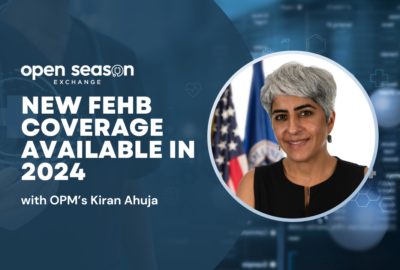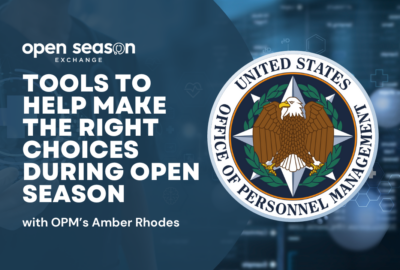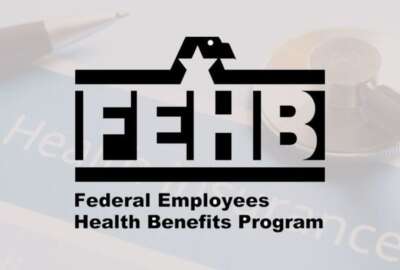Open Season Exchange 2023: Kevin Moss of Consumers’ Checkbook on what you need to know about FEHB plans in 2024
Don’t just roll over your plan, says Kevin Moss, who researches FEHB plans for Consumers’ Checkbook. “It’s quite possible that you’re overpaying versus...
If you want a reliable source of accurate information, turn to an encyclopedia. For information on the upcoming year’s Federal Employee Health Benefits Plan options, we found a human encyclopedia: Kevin Moss, editor of the Consumers’ Checkbook Guide to Health Plans for Federal Employees 2024.
During Federal News Network’s 2024 Open Season Exchange, Moss detailed what working and retired federal employees can expect as this year’s open season gets underway.
First off, Moss said, don’t pay attention to threats of a lapse in appropriations or the concerns about possible government shutdowns. Open season and health insurance itself will continue irrespective of what happens on the political front.
The FEHB process “will all happen as it normally does,” he said. “Make sure you go through your agency and follow your agency’s instructions in terms of signing up for your health plan. And worst case scenario, even if there is an interruption, you would just keep your same health plan next year. That’s how FEHB works.”
Moss detailed how premiums will change next year. On average, they’ll rise 7.7%, a solid jump, but at least lower than last year’s average rise of 8.7%.
How come?
“When the Office of Personnel Management was talking about these premium increases, they were referencing higher prescription drug usage and higher outpatient care as reasons why these premiums went up,” Moss said. He said private industry health care insurance will also go up next year by around 7%.
Disappearing FEHB plans in 2024
Federal employees and annuitants will have fewer plans to choose from for next year, Moss said. Last year, the FEHB program had 271 plans. That dropped to 156 this year. The main reason is that Humana, which offered plans via health maintenance organizations in Florida, Texas and across the Midwest, dropped out of the program. Ditto for the Indiana University Health Plan.
Kaiser Permanente still offers HMOs in Atlanta, Denver, Hawaii, several cities in California and the Pacific Northwest, and the Washington, D.C., area. Moss cautioned: “Kaiser is very specific — that both the human providers and the facilities themselves are all Kaiser-branded. It’s very different than many other, even local HMO plans.”
Some providers offered new plans for 2024, Moss said. Compass Rose added a standard plan, for example. Sentara Health expanded out of the Newport News, Virginia, area to the Northern Virginia area, where tens of thousands of federal employees live.
Although only a small percentage of feds switch plans year to year, Moss said it’s wise to look at your options.
“Even if you’re not motivated to switch your health plan, you still have homework to do every open season,” he said. If nothing else, you’ll want to be sure your current plan is still available and also discover whether any new options have come into your area.
Moss pointed out that prices of specific plans vary, and not all are on the rise.
“In fact, for some plans, the premiums actually went down,” Moss said. “There’s a plan in Texas where the premium went down 50%. It’s Baylor Scott & White. That’s going to save a self-only enrollee about $1,300 next year.”
Some plans shot up as much as 20%, while others will price about level with this year, Moss said. He advised feds to make price only one of their considerations when choosing plans and to also consider specific coverage needs. For more pricing detail, he noted, simply consult the last page of each FEHB plan brochure.
“That’s the premium table,” Moss said. “It shows you what you’ll pay.” The table details prices for self-enrollees, self-plus-one and families. It states prices on a per-pay-period basis.
People with a spouse or partner, but without dependent children, often ask whether they should choose self or self-plus-one.
“If you have two federal employees that are married, you are entitled to have your own plan as a self-only enrollment,” Moss said. “And oftentimes, that’s a way to save some money.”
Anticipating differing medical needs constitutes one reason for self-only by rather than self-plus-one.
Moss added, “But keep in mind that if you if you do make that [self-only] decision, there’ll be an individual deductible each person then will have to face versus both people together in a plan.”
FEHB deductible considerations
A household member thinking he or she might need minimal health care should consider a plan with a high-deductible limit but a relatively lower premium, Moss said. Some high-deductible plans put a portion of a member’s premium into a health savings account (HCA), which has the effect of lowering the plan holder’s out-of-pocket expenses.
The additions typically range from $900 to $1,200, divided over 12 months, Moss said, so you’ll have more at the end of the year than at the beginning.
“And if you’re able to put in a little additional money on your own, this is a really important way for federal employees to save money for health care expenses now and in the future,” he said.
He pointed out that when you turn 65, “you can use those funds in an HSA for nonqualified health care expenses.”
Moss added: “You have to pay normal taxes if you do decide to do that. But basically, it turns into an IRA at that point. You can use it any way that you want.” That includes dental, vision and hearing loss care. Moss said that retirees can use the resulting funds to offset the costs of Medicare Part B premiums.
Plus, HSAs are generally managed by financial services companies, giving the HSA owner choices of investments. “It grows tax free. So any investment returns you receive, you keep tax free,” Moss said. Only on withdrawals after age 65 would you have to pay taxes.
Feds can save a solid amount of money in this manner. “We know many federal employees that have $25,000, $30,000 or $40,000 in their health savings account because they’ve been doing it for a long time,” Moss said.
Attention annuitants
Moss discussed a few items of particular interest to federal retirees. Among the top considerations: Medicare Part D, which covers prescription drug costs. Until now, annuitants didn’t have to think about Part D, Moss said, because drug coverage under most FEHB plans “were as good or better than what you could get from a Medicare Part D plan.”
But a provision in the 2022 Inflation Reduction Act reformed Medicare Part D. For example, it instituted a cap of $35 per month out-of-pocket limit for insulin this year. Starting in 2024, the law ends cost sharing by individuals for catastrophic drug coverage for Part D enrollees with prescription drug expenses of more than $8,000. Then, Moss said, in 2025 comes an out-of-pocket limit of $2,000 for drugs under any Part D plan.
“If you have moderate to high prescription drug costs, this $2,000 cap is going to be really, really important for you,” Moss said. OPM, he added, anticipated these changes “and challenged the plans to offer more Part D coverage to federal annuitants. And the plans have responded.”
Moss said that next year, 17 prescription drug plans will become available under FEHB plans.
“In order for them to be approved by OPM,” Moss said, “they had to offer as good or better prescription drug coverage. We’ve looked at it, and it’s true. It’s as good or better.” He said some plans — including plans from Aetna, Blue Cross Blue Shield and MHBP Federal — went ahead and offered the $2,000 out-of-pocket drug cost limit a year early.
High-income annuitants, as defined by the Centers for Medicare and Medicaid Services, can opt out of Part D, Moss said. That means individuals with $103,000 in adjusted gross income and $206,000 for couples. They would have to pay something called the income-related monthly adjustment, or IRMA. But the adjustment is only $13 a month, he said.
“What’s probably true is that the value of those increased prescription drug benefits are going to be worth more than that Part D IRMA,” Moss said.
He added that annuitants in Medicare Part A or parts A and B who have one these plans, will receive automatic enrollment in the Part D coverage. This includes three Blue Cross Blue Shield plans that cover two-thirds of federal employees and annuitants.
Worth the homework
Above all, Moss urged, take the time to examine the options rather than simply roll over to the same plan.
“Even if you don’t think you want to switch your health plan, don’t assume that your health plan is exactly the same,” Moss said. “We already know the premiums are probably different. Some benefits probably have changed too.” He said the best place check is simply section two of your plan brochure. Brochures are available both at OPM’s website and at that of Consumers’ Checkbook.
As an example of how a plan can change, United Choice Plus Advanced will double its catastrophic limit to $6,000 for self-only members and to $12,000 for self-plus-one, Moss said. “That’s a really big change,” he said. “You have a lot more risk in that plan in 2024 than in 2023.”
Blue Cross Blue Shield plans will add marital and family counseling as part of their mental health services, Moss said.
Also in 2024, plans will expand certain drugs for in-vitro fertilization, although those undergoing fertility treatments will continue to have significant out-of-pocket expenses. A few plans will go further. Moss cited Blue Cross Standard, which will cover up to $25,000 for assisted reproductive technologies including IVF and artificial insemination. Moss called that a huge improvement.
Fertility coverage “is new territory because this is a big expansion of benefits that previously weren’t available,” he said.
Above all, take the time to check out the options. “Far too few will change their health plan in any given year,” Moss said. On average, about 5% do.
“Unless you have an adverse experience, most federal employees will just keep the plan they have,” he said. “The danger in doing that, especially on the annuitants’ side, is there’s a lot of innovation that’s happening, ways for you to save money. If you’re not looking at it, you’re missing out on better benefits. It’s quite possible that you’re overpaying versus some less expensive options that could provide just as good or, in some cases, maybe even better coverage for a lower price.”
Whatever you choose, you won’t find a so-called junk plans in the FEHB program, Moss said.
“OPM has structured this system for you never to have a situation where you would find yourself having something not being covered and have an insurmountable amount of medical debt. That’s really not going to happen in the FEHB program.”
To discover more insights and advice shared during the 2024 Open Season Exchange, visit the event page.
Copyright © 2025 Federal News Network. All rights reserved. This website is not intended for users located within the European Economic Area.
Tom Temin is host of the Federal Drive and has been providing insight on federal technology and management issues for more than 30 years.
Follow @tteminWFED






